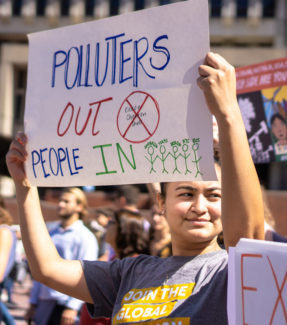Opinion piece by
President Trump campaigned on — and continues to promise — a populist agenda, most recently in his State of the Union address, in which he called on Congress to pass a trillion-dollar infrastructure package. But if his rubbing shoulders with Davos elite last week weren’t enough to dispel any hopes of him delivering on his populist posturing, the emerging details of that infrastructure plan surely is.
Mr. Trump’s budget proposal and infrastructure “principles” released last May, and an outline of the plan leaked last month, point to a pro-privatization approach that his pals in Davos would celebrate but would endanger basic services, enrich the private sector and force everyday people to foot the bill. The leaked plan would be a bonanza for giant corporations, prioritizing projects that raised revenue (toll roads, higher water rates) and giving very little weight to a project’s social benefit.
In his address Tuesday, Mr. Trump called for $1.5 trillion for infrastructure, yet his top adviser on the project, DJ Gribbin, has maintained that the plan wouldn’t include any new federal revenue. That means funds will come from elsewhere, like existing transportation budgets. Because revenue, not need, would be prioritized, cities could be forced to turn to so-called public-private partnerships — a less politically charged rebranding of privatization — that has often led to higher user fees. And that focus makes sense, since this administration is full of with champions of privatization, including Mr. Gribbin, Vice President Mike Pence and Gary Cohn, the National Economic Council director.
Infrastructure privatization raises costs for basic services, undermines transparency and is frequently used to keep government costs “off the books.” Disastrous examples in the United States include a deal by the water company Suez and the private equity firm Kohlberg Kravis Roberts to privatize the water system in Bayonne, N.J., which has left some residents in danger of losing their homes after skyrocketing water rates.
Although business executives, national officials and other global financiers and deal-makers may disagree with Mr. Trump on trade, they are with his administration on infrastructure privatization. The World Bank, to take a prominent example, has a long history of pushing the privatization of people’s most basic infrastructure need — water. Perhaps the best-known example is Cochabamba, Bolivia, where popular opposition to the privatization of the water system forced a return to a publicly run system in 2000. In another failed privatization, this time branded as a public-private partnership, residents of Manila face unreliable access, infrastructure neglect and rates that are unaffordable for many.
While the World Bank claims to have no preference between public and private infrastructure, promoting public-private partnerships remains its bread and butter. At a 2016 training event, bank staff learned “how to promote water P.P.P. projects” and convince government officials “of the interest of the P.P.P. approach.” What’s more, bank leadership is now evangelizing what it calls the “Cascade” approach, which prescribes the bank to “first consider private investment for projects; then public-private partnerships; and if the first two are not available then, only then, consider public finance.”
The budget of the World Bank’s International Development Association, which advances the bank’s development priorities in the lowest-income countries, recently added $2.5 billion to provide corporations with risk insurance, guarantees, loans and equity investments.
The Trump administration and World Bank leadership clearly have shared interests, despite Mr. Trump’s threat of deep cuts to development funding. The bank’s president, Jim Yong Kim, has raised eyebrows by offering bank staff members to advise Mr. Trump on infrastructure policy. At a World Bank conference last October, Treasury Secretary Steven Mnuchin praised what he called the Cascade approach’s key pillar: that the World Bank “will not provide financing if the private sector is able to do so.” Perhaps this shared pro-corporate vision is why Mr. Trump has proposed funding the World Bank at levels close to the Obama-era budget last year.
As Puerto Rico’s dire situation proves, the United States, like much of the rest of the world, has critical infrastructure problems to fix. But the privatization solution promoted by the Trump administration and popular among global elite is not the answer. Already, the toll that privatization takes has provoked resistance from Pittsburgh to Lagos.
Lawmakers at every level must take a stand by refusing a privatization agenda, whether from the Trump administration or the World Bank, and calling for renewed and expanded public funding. We need a plan that increases public investment, especially federal funding, not one that yields control to profit-maximizing and unaccountable corporations.



